Swallow Falls, Garrett County
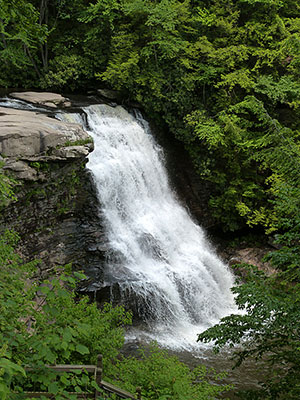 Few forests in Maryland can be characterized as old growth, meaning they survived the widespread cutting of trees that occurred in the eastern United States from the late 1800s to the early 1900s. Nestled within Swallow Falls State Park and hugging the Youghiogheny River
is Maryland's oldest grove of eastern hemlock and white pine, some
of which are reported to be at least 360 years old. A hike along the
Canyon Loop trail leads visitors through these sentinels to the
spectacular Muddy Creek Falls, a 53-foot cascade waterfall and
the highest in Maryland.
Few forests in Maryland can be characterized as old growth, meaning they survived the widespread cutting of trees that occurred in the eastern United States from the late 1800s to the early 1900s. Nestled within Swallow Falls State Park and hugging the Youghiogheny River
is Maryland's oldest grove of eastern hemlock and white pine, some
of which are reported to be at least 360 years old. A hike along the
Canyon Loop trail leads visitors through these sentinels to the
spectacular Muddy Creek Falls, a 53-foot cascade waterfall and
the highest in Maryland.
In the summer of 1921, three men who changed our nation camped
here beside Muddy Creek Falls. Calling themselves "the Vagabonds",
Thomas Edison, Henry Ford, and Harvey Firestone found peace and
solace in this natural sanctuary. Down the trail ahead, visitors will
be treated to two other falls: the Lower and Upper Swallow Falls.
Swallow Falls was named for the rock pillar that once housed
hundreds of nesting cliff swallows. It is not clear as to why these
social birds no longer nest there, but it is thought the swallows
relocated their colony to an area with less human disturbance.
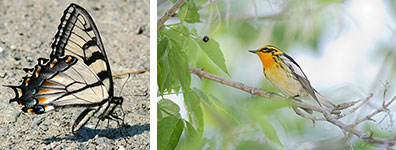
Flying Jewels
In May, hikers may be treated to the thin,
high-pitched "zip-zip" or "teetsa" song of
a male blackburnian warbler staking out
his territory. After the young have fledged,
blackburnians will gather with foraging
flocks of chickadees, nuthatches, and
kinglets in the mature evergreen forests.
Even though cliff swallows may no longer
be nesting at Swallow Falls Natural Area,
visitors may spy another "swallow": the
recently discovered Appalachian tiger
swallowtail. This butterfly is found only
in eastern mountainous regions and is
much larger and paler than the eastern
tiger swallowtail. An abundance of dragonflies
patrol the Youghiogheny River, in
their constant search for mosquitoes, flies
and other small insect prey. Dragonfly
seekers will likely see black-shouldered
spinylegs and perhaps the rare sable
clubtail (Gomphus rogersi).
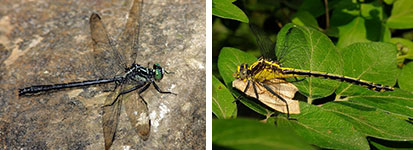
The Rarest of Rare Forests
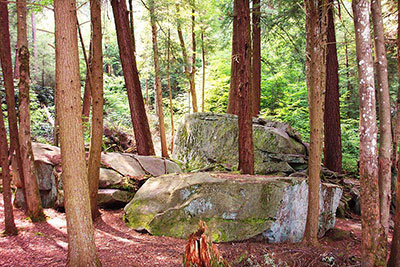
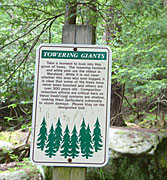 Forests are generally considered "old growth" if they have not been logged
or significantly disturbed by people since the 1700s. Of the 2.7 million
acres of forest in Maryland, 2,000 acres are officially designated as old growth
and 1.8% of that is hemlock forest. This park shelters the same precious
37 acres of hemlocks and white pines so loved as a camping spot by the
Vagabonds. Not many old growth forests remain in the eastern U.S. and
fewer still are as easily accessible to hikers. Though these trees escaped the
axe, they now face a tiny but
deadly threat from the hemlock
woolly adelgid, an Asian insect that
literally sucks the life out of the tree
by feeding on young twig tissue and
its stored starches vital for growth.
The department's efforts to save the 300 year old
hemlocks began in May 2011 using
predatory beetles similar to ladybugs,
and soil and tree insecticide injections.
Only time will tell if future vagabonds
will find peace under the same treasured
trees that once sheltered history.
Forests are generally considered "old growth" if they have not been logged
or significantly disturbed by people since the 1700s. Of the 2.7 million
acres of forest in Maryland, 2,000 acres are officially designated as old growth
and 1.8% of that is hemlock forest. This park shelters the same precious
37 acres of hemlocks and white pines so loved as a camping spot by the
Vagabonds. Not many old growth forests remain in the eastern U.S. and
fewer still are as easily accessible to hikers. Though these trees escaped the
axe, they now face a tiny but
deadly threat from the hemlock
woolly adelgid, an Asian insect that
literally sucks the life out of the tree
by feeding on young twig tissue and
its stored starches vital for growth.
The department's efforts to save the 300 year old
hemlocks began in May 2011 using
predatory beetles similar to ladybugs,
and soil and tree insecticide injections.
Only time will tell if future vagabonds
will find peace under the same treasured
trees that once sheltered history.
Click here for a Print Version of this map.
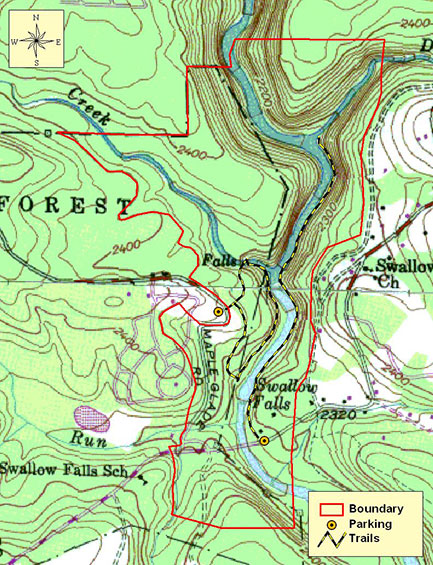
Swallow Falls Natural Area
Directions
From Frederick: Take I-70 west to I-68 at Hancock. Continue
on I-68 about 65 miles to Exit 14. Follow US 219 (Garrett
Highway) south about 19 miles to Mayhew Inn Road (a few miles
beyond Deep Creek Lake). Turn right and follow Mayhew Inn
Road about 4.5 miles to its end at Oakland Sang Run Road. Turn
left at the stop sign and continue 0.3 mile to the first right-hand
turn. Bear right onto Swallow Falls Road and proceed 1.2 miles
to Maple Glade Road. Turn right to the entrance for Swallow
Falls State Park.
Driving directions and aerial views open with Google Maps. For the aerial view button, if an aerial view does not open by default, click on the Satellite icon in the upper right corner and Google Maps will switch to an aerial view of the Natural Area.
